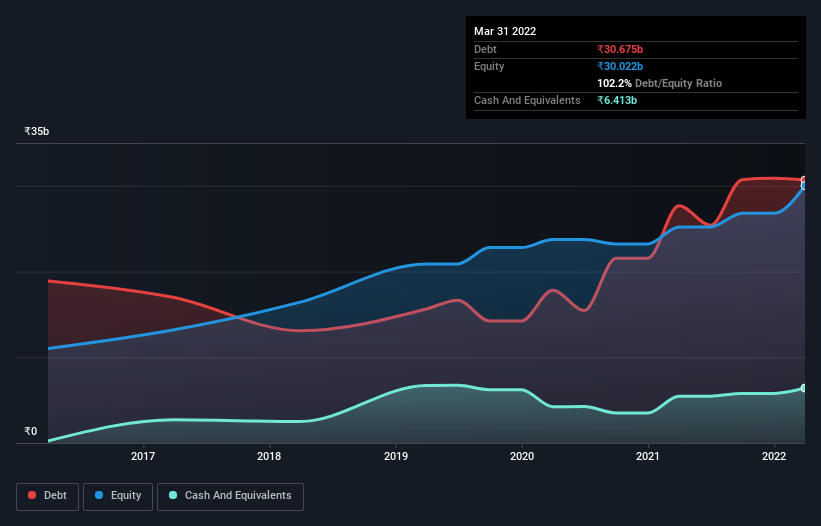- India
- /
- Paper and Forestry Products
- /
- NSEI:JKPAPER
Does JK Paper (NSE:JKPAPER) Have A Healthy Balance Sheet?
Some say volatility, rather than debt, is the best way to think about risk as an investor, but Warren Buffett famously said that 'Volatility is far from synonymous with risk.' So it seems the smart money knows that debt - which is usually involved in bankruptcies - is a very important factor, when you assess how risky a company is. We can see that JK Paper Limited (NSE:JKPAPER) does use debt in its business. But is this debt a concern to shareholders?
When Is Debt Dangerous?
Debt and other liabilities become risky for a business when it cannot easily fulfill those obligations, either with free cash flow or by raising capital at an attractive price. Part and parcel of capitalism is the process of 'creative destruction' where failed businesses are mercilessly liquidated by their bankers. However, a more frequent (but still costly) occurrence is where a company must issue shares at bargain-basement prices, permanently diluting shareholders, just to shore up its balance sheet. By replacing dilution, though, debt can be an extremely good tool for businesses that need capital to invest in growth at high rates of return. The first step when considering a company's debt levels is to consider its cash and debt together.
View our latest analysis for JK Paper
What Is JK Paper's Debt?
You can click the graphic below for the historical numbers, but it shows that as of March 2022 JK Paper had ₹30.7b of debt, an increase on ₹27.7b, over one year. However, because it has a cash reserve of ₹6.41b, its net debt is less, at about ₹24.3b.

How Healthy Is JK Paper's Balance Sheet?
According to the last reported balance sheet, JK Paper had liabilities of ₹13.0b due within 12 months, and liabilities of ₹33.2b due beyond 12 months. Offsetting these obligations, it had cash of ₹6.41b as well as receivables valued at ₹2.59b due within 12 months. So its liabilities outweigh the sum of its cash and (near-term) receivables by ₹37.2b.
This deficit is considerable relative to its market capitalization of ₹56.0b, so it does suggest shareholders should keep an eye on JK Paper's use of debt. This suggests shareholders would be heavily diluted if the company needed to shore up its balance sheet in a hurry.
In order to size up a company's debt relative to its earnings, we calculate its net debt divided by its earnings before interest, tax, depreciation, and amortization (EBITDA) and its earnings before interest and tax (EBIT) divided by its interest expense (its interest cover). This way, we consider both the absolute quantum of the debt, as well as the interest rates paid on it.
JK Paper's net debt of 2.2 times EBITDA suggests graceful use of debt. And the fact that its trailing twelve months of EBIT was 7.0 times its interest expenses harmonizes with that theme. Pleasingly, JK Paper is growing its EBIT faster than former Australian PM Bob Hawke downs a yard glass, boasting a 105% gain in the last twelve months. The balance sheet is clearly the area to focus on when you are analysing debt. But ultimately the future profitability of the business will decide if JK Paper can strengthen its balance sheet over time. So if you're focused on the future you can check out this free report showing analyst profit forecasts.
Finally, while the tax-man may adore accounting profits, lenders only accept cold hard cash. So we always check how much of that EBIT is translated into free cash flow. During the last three years, JK Paper burned a lot of cash. While that may be a result of expenditure for growth, it does make the debt far more risky.
Our View
Neither JK Paper's ability to convert EBIT to free cash flow nor its level of total liabilities gave us confidence in its ability to take on more debt. But its EBIT growth rate tells a very different story, and suggests some resilience. Looking at all the angles mentioned above, it does seem to us that JK Paper is a somewhat risky investment as a result of its debt. That's not necessarily a bad thing, since leverage can boost returns on equity, but it is something to be aware of. The balance sheet is clearly the area to focus on when you are analysing debt. But ultimately, every company can contain risks that exist outside of the balance sheet. For example, we've discovered 3 warning signs for JK Paper that you should be aware of before investing here.
At the end of the day, it's often better to focus on companies that are free from net debt. You can access our special list of such companies (all with a track record of profit growth). It's free.
New: Manage All Your Stock Portfolios in One Place
We've created the ultimate portfolio companion for stock investors, and it's free.
• Connect an unlimited number of Portfolios and see your total in one currency
• Be alerted to new Warning Signs or Risks via email or mobile
• Track the Fair Value of your stocks
Have feedback on this article? Concerned about the content? Get in touch with us directly. Alternatively, email editorial-team (at) simplywallst.com.
This article by Simply Wall St is general in nature. We provide commentary based on historical data and analyst forecasts only using an unbiased methodology and our articles are not intended to be financial advice. It does not constitute a recommendation to buy or sell any stock, and does not take account of your objectives, or your financial situation. We aim to bring you long-term focused analysis driven by fundamental data. Note that our analysis may not factor in the latest price-sensitive company announcements or qualitative material. Simply Wall St has no position in any stocks mentioned.
About NSEI:JKPAPER
Excellent balance sheet and good value.
Similar Companies
Market Insights
Community Narratives



